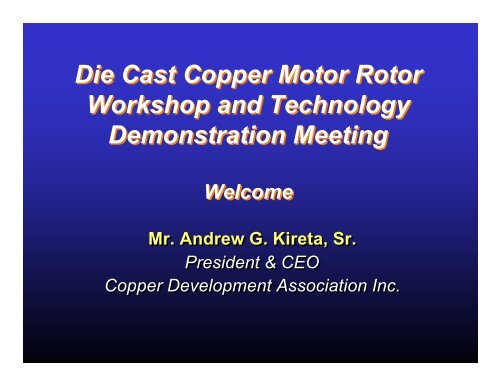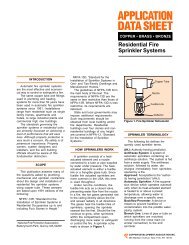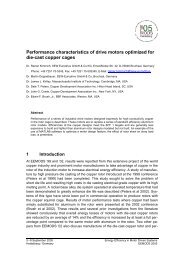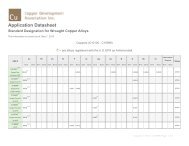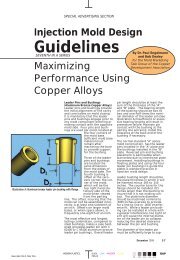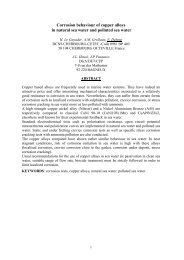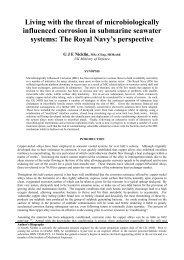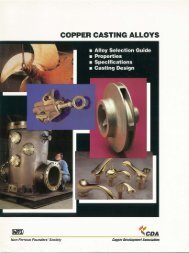Die Casting Copper Rotors - Copper Development Association
Die Casting Copper Rotors - Copper Development Association
Die Casting Copper Rotors - Copper Development Association
You also want an ePaper? Increase the reach of your titles
YUMPU automatically turns print PDFs into web optimized ePapers that Google loves.
<strong>Die</strong> Cast <strong>Copper</strong> Motor RotorWorkshop and TechnologyDemonstration MeetingWelcomeMr. Andrew G. Kireta, Sr.President & CEO<strong>Copper</strong> <strong>Development</strong> <strong>Association</strong> Inc.
<strong>Die</strong> <strong>Casting</strong> BackgroundDr. Dale T. PetersConsultant<strong>Copper</strong> <strong>Development</strong> <strong>Association</strong> Inc.
IntroductionProgram initiation - Background? <strong>Development</strong> encouraged by motor manufacturers? Program members include:– Motor manufacturers– <strong>Die</strong>-cast equipment manufacturers– Mold materials suppliers– <strong>Copper</strong> industry technical & financial support? Members all contributing to process development
IntroductionParticipants? CDA— program management & technical direction? ICA— major copper industry support? US Dept. of Energy— NICE 3 /OIT contributed $425,000? Motor Manufacturers (multiple)? Air Conditioning & Refrigeration Institute? CDA Members – alloy testing suggestions? Formcast— die casting/technology capability
IntroductionObjectives? <strong>Development</strong> of mold (die) materials and processingfor cost-effective copper motor rotor manufacturing? Electrical energy efficiency improvement
IntroductionBackgroundMultiple analyses show additional 15% to 20%reduction in motor losses (input/output method)achievable with copper rotor compared to same motordesign using aluminum.
IntroductionAdvantages to motor performance -scenarios for manufacturers and users? Improvement in motor electrical energy efficiency toreduce user operating costs? Reduction in overall premium motor manufacturingcost at existing efficiency? Reduction in potential motor weight
<strong>Die</strong> Materials TestingProblem with common mold materials:? High temperature? Substantial latent heat? Thermal shock? Thermal fatigue (heat checking)? High operating temperature: Loss of strength? In previous studies: tool steel molds lasted only afew shots
Cracking –Thermal Expansion & Contraction<strong>Die</strong> filled withliquid <strong>Copper</strong>t = initialDwell time: Cusolidifyingt = 1.5 minutesCu separatedfrom diet = 2.0 minutesCu castingremovedt = 2.5 minutes<strong>Die</strong> Cu <strong>Die</strong> Cu <strong>Die</strong> Cu <strong>Die</strong>TTmTTmTTmTTmx x x x
<strong>Die</strong> Materials TestingInsert die sets used in material evaluations
<strong>Die</strong> Materials TestingH-13 tool steel die cavity insert tool set
Thermal ModelingModeling studiesTemperature profiles in H-13die inserts during cooling cycle
Predicted Temperature Profiles
Actual Temperature Profiles
The <strong>Die</strong> <strong>Casting</strong> ProcessSystem design at Formcast test facility? 660 metric-ton Buhler SC (independent computercontrolled - closure & shot)? Induction melting (15 kg of copper in 9 minutes forrotors – earlier design used 4 kg of copper per 2minute cycle for material testing)? High-temperature mold (die) materials and handlingto achieve long life-in-service
The <strong>Die</strong> <strong>Casting</strong> ProcessBühler horizontal die caster
The <strong>Die</strong> <strong>Casting</strong> ProcessInductotherm induction furnace
The <strong>Die</strong> <strong>Casting</strong> Process<strong>Die</strong> halves – H-13 tool steel
The <strong>Die</strong> <strong>Casting</strong> ProcessApplying dry film lubricant
The <strong>Die</strong> <strong>Casting</strong> ProcessMeasuring copper charge
The <strong>Die</strong> <strong>Casting</strong> ProcessTransferring molten copper to shot sleeve
The <strong>Die</strong> <strong>Casting</strong> ProcessPouring copper into shot sleeve
The <strong>Die</strong> <strong>Casting</strong> ProcessEjecting copper casting and runner
The <strong>Die</strong> <strong>Casting</strong> ProcessExtracting die cast copper
Testing <strong>Die</strong> MaterialsDr. John G. CowieVice President<strong>Copper</strong> <strong>Development</strong> <strong>Association</strong> Inc.
Testing of <strong>Die</strong> Materials – H-13 SteelFirst <strong>Casting</strong> Trial:H-13 Steel <strong>Die</strong>sBaseline Data
Testing of <strong>Die</strong> Materials – H-13 SteelVisual Examination – Thermal Fatigue CracksShot # 9 Shot # 800
Testing of <strong>Die</strong> Materials – H-13 SteelMacrostructure of die cast copper
Testing of <strong>Die</strong> Materials – H-13 SteelMicrostructure of die cast copper near gate region
Testing of <strong>Die</strong> Materials – H-13 SteelMicrostructure of die cast copper
Testing of <strong>Die</strong> Materials – H-13 SteelIron & Oxygen ContaminationIronOxygenShotContentContentNumberppm wt. %9 17 0.05911 350 0.11438 56 0.15600 61 0.057800 10 0.055
Testing of <strong>Die</strong> Materials – H-13 Tool SteelConductivityAverageShot Number% IACS9 97.811 95.2438 96.8600 99.7800 99.4Average 98.8
Testing of <strong>Die</strong> Materials – H-13 SteelAlternative Shot Sleeves? Liner insert below pouring hole? Reduced erosion & wear? Reduced contamination of copper? Retained electrical conductivity in cast copper? Remelting runners and gates sections
Testing of <strong>Die</strong> Materials – CVD-W & TZMSecond <strong>Casting</strong> Trial:Chemical Vapor Deposition(CVD) Tungsten Coated onTZM Modified Molybdenum<strong>Die</strong>s
Testing of <strong>Die</strong> Materials – CVD-W on TZMCVD tungstenAfter 50 shots, cracking from ejector pin holes andheat-checking. Preheated 350 C.
Testing of <strong>Die</strong> Materials – InconelThird <strong>Casting</strong> Trial:Nickel Alloy <strong>Die</strong>s -617718MA-754
Testing of <strong>Die</strong> Materials – InconelVisual examinationPreheat 320 C to 410 CShot # 50 Shot # 235
Testing of <strong>Die</strong> Materials – InconelAlloy comparisonAlloyHeat Checking ObservedMA 754 Shot# 50718 Shot# 100617 Shot# 200 (minor crazing)
Testing of <strong>Die</strong> Materials – InconelPorosity
Testing of <strong>Die</strong> Materials – InconelElectrical conductivityShot Number% IACS50 99.4150 99.1235 101.2Average 99.9
Testing of <strong>Die</strong> Materials – TZM & AnviloyFourth <strong>Casting</strong> Trial:TZM & Anviloy <strong>Die</strong>s
Testing of <strong>Die</strong> Materials – TZM & AnviloyTZM & Anviloy dies? TZM (molybdenum alloy)? Oxidized at die operating temperatures? Anviloy (tungsten alloy)? Brittle below 450C? Difficult to machine
Testing of <strong>Die</strong> Materials – TZM & AnviloyAnviloy dies? Moving half? Preheat 450C to 560C
Testing of <strong>Die</strong> Materials – Nickel Alloys #2Fifth <strong>Casting</strong> Trial:Nickel Alloy <strong>Die</strong>s 617 & 625at Elevated Temperature
Testing of <strong>Die</strong> Materials – Nickel Alloys #2Inconel Alloy <strong>Die</strong>s at Elevated Temperature? After 950 shots, minor cracking? Preheat 560C to 660C
<strong>Die</strong> Materials TestingInitial findings? Multiple high-temperature mold (die) materials mayperform adequately in various die locations—depending upon thermal stresses/load requirements? Mold (die) material handling—preheat requirementsare critical—to reduce thermal stresses and assurelong die-life in-service
Alloy<strong>Die</strong> Materials TestingNickel-based superalloy compositions (wt.%)NiCoCrMo W FeAl C Others230 Bal. 5* 22 2 14 3* 0.3 0.1 0.4 Si, , 0.5 Mn,0.02 La617 Bal. 12.5 22 9 - 1.5 1.2 0.07 0.30 Ti625 Bal. 1* 21 9 - 5* 0.4* 0.1* 0.4* Ti, 0.5 Mn3.7 Nb+Ta* maximum
Alloy<strong>Die</strong> Materials TestingSuperalloy comparison – 0.2% YS (MPa)20C540C650C760C870C980C1100C230 393 276 269 283 221 124 57617 352 228 214 221 214 110 55625 490 372 372 345 207 83 39
Alloy<strong>Die</strong> Materials TestingSuperalloy comparison – UTS (MPa)20C540C650C760C870C980C1100C230 862 710 669 586 400 228 117617 759 593 565 503 352 200 110625 903 772 759 600 345 166 97
Alloy<strong>Die</strong> Materials TestingSuperalloy comparison – % elongation20C540C650C760C870C980C1100C230 48 56 55 46 59 71 50617 58 64 69 56 54 64 50625 49 54 56 53 46 44 45
<strong>Die</strong> Materials TestingConclusions – Phase I of study? Five copper die casting trials completed? Inconel alloy 617 best candidate testedHaynes alloy 230 alternate die material? Must run dies hot: 650C? <strong>Copper</strong> microstructure exhibited minor defects? Conductivity very good? Elimination of iron in system should improveconductivity? Reduction of oxygen contamination should improveductility
Rotor <strong>Die</strong> <strong>Casting</strong>Dr. Edwin Brush (Ned)ConsultantBBF & Associates
<strong>Die</strong> <strong>Casting</strong> <strong>Copper</strong> <strong>Rotors</strong>Master die set for casting rotorsEjector SectionCenter SectionStationary SectionAlternate (Thick)Center Section
<strong>Die</strong>-Cast <strong>Copper</strong> Motor RotorModeling Studies
<strong>Die</strong> <strong>Casting</strong> <strong>Copper</strong> <strong>Rotors</strong>Larger Induction melting furnaceInductotherm
<strong>Die</strong> <strong>Casting</strong> <strong>Copper</strong> <strong>Rotors</strong><strong>Die</strong> cavity inserts — gates and runner
<strong>Die</strong> <strong>Casting</strong> <strong>Copper</strong> <strong>Rotors</strong>Arbor (Mandrel)
<strong>Die</strong> <strong>Casting</strong> <strong>Copper</strong> <strong>Rotors</strong>Core stack being assembled
<strong>Die</strong> <strong>Casting</strong> <strong>Copper</strong> <strong>Rotors</strong>Assembled core stacks
<strong>Die</strong> <strong>Casting</strong> <strong>Copper</strong> <strong>Rotors</strong>Compressing laminations
<strong>Die</strong> <strong>Casting</strong> <strong>Copper</strong> <strong>Rotors</strong>Inserting laminations (core stack)
<strong>Die</strong> <strong>Casting</strong> <strong>Copper</strong> <strong>Rotors</strong>Inductotherm (Induction melting) furnace
<strong>Die</strong> <strong>Casting</strong> <strong>Copper</strong> <strong>Rotors</strong><strong>Copper</strong> pellets melting in the crucible
<strong>Die</strong> <strong>Casting</strong> <strong>Copper</strong> <strong>Rotors</strong>Removing crucible from furnace
<strong>Die</strong> <strong>Casting</strong> <strong>Copper</strong> <strong>Rotors</strong>Pouring copper into the shot sleeve
<strong>Die</strong> <strong>Casting</strong> <strong>Copper</strong> <strong>Rotors</strong>Programming computer controlled die-caster
<strong>Die</strong> <strong>Casting</strong> <strong>Copper</strong> <strong>Rotors</strong>Ejecting rotor with runner
<strong>Die</strong> <strong>Casting</strong> <strong>Copper</strong> <strong>Rotors</strong>Extracting rotor
<strong>Die</strong> <strong>Casting</strong> <strong>Copper</strong> <strong>Rotors</strong>Water-quenching rotor
<strong>Die</strong> <strong>Casting</strong> <strong>Copper</strong> <strong>Rotors</strong>Fin detail - complete fill on a large rotor
<strong>Die</strong> <strong>Casting</strong> <strong>Copper</strong> <strong>Rotors</strong>Cross-section of a cast copper rotor
<strong>Die</strong> <strong>Casting</strong> <strong>Copper</strong> <strong>Rotors</strong>Rotor die-casting? Rotor die casting evaluation runs for four motorcompanies completed? Evaluation of prototype motor performance - three setsof results (next)? Run of 200 to 500 rotors for production motorsplanned
Rotor Steel Specification for <strong>Copper</strong>Recommend Review of Current SpecificationsDeveloped for Aluminum <strong>Die</strong> <strong>Casting</strong>Indications to Date:? High temperature anneals, utilized in many “larger"rotors, appear NOT affected –? No increases in losses observed (IEEE Tests)? Low temperature anneals, utilized in some “smaller"rotors, appear affected? Increases in core (Iron) losses observed
Target for OpportunityAdvantages to motor performance -scenarios for manufacturers and users? Improvement in motor electrical energy efficiency toreduce user operating costs? Reduction in overall premium motor manufacturingcost at existing efficiency? Reduction in potential motor weight
Capabilities for Future <strong>Die</strong> <strong>Casting</strong>System design at Formcast test facility? 660 metric-ton Buhler SC (independent computercontrolled - closure & shot)? Induction melting (15 kg of copper in 9 minutes forrotors – earlier design used 4 kg of copper per 2minute cycle for material testing)? High-temperature mold (die) materials and handlingto achieve long life-in-service
<strong>Die</strong>-Cast <strong>Copper</strong> Motor RotorModeling Studies
Motor Test ResultsMr. Darryl Van SonConsultant<strong>Copper</strong> <strong>Development</strong> <strong>Association</strong> Inc.
Motor TestsWhat is 1% motor efficiency worth? (USA)? Two-thirds (2/3) of all industrial electricity is used torun motors? Motors use 680 Billion kW-Hr per year1% better motor efficiency would save:? 6.8 Billion kW-Hr per year? $US 500 Million at 7 cents per kW-Hr? Equivalent to 13 Million barrels of oil
Diminishing ReturnsLossesWe arehereCosts toFurtherReduceLosses$Time
Motor TestsEfficiencyLossHPkWPolesAlCuDifferenceReduction4 3 4 83.2 86.4 3.2 19.0%7.5 5.5 4 74.0 79.0 5.0 19.2%10 7.5 4 85.0 86.5 1.5 10.0%15 11 4 89.5 90.7 1.2 11.4%25 19 4 90.9 92.5 1.6 17.6%40 30 4 88.8 90.1 1.3 11.6%120 90 2 91.4 92.8 1.4 16.3%270 200 4 92.0 93.0 1.0 12.5%Average: 14.7%
Motor TestsRotor I 2 R Losses (Watts)HPkWPolesAlCuDifferenceReduction4 3 4 221 92 129 - 58%5 3.7 4 - - - - 38%15 11 4 262 157 104 - 40%25 19 4 410 292 118 - 40%
Motor TestsTemperature RiseAICuDifference Percent15 HP (11kW) Motor 64.9C 59.5C - 4.5C - 7%25 HP (18.5 kW) Motor 79.9C 47.2C - 32.7C - 41%? Affects life expectancy of the motor? For every 10 degrees C hotter a motor runs,life can be reduced in half? <strong>Copper</strong> rotors could increase life expectancy? Similar results have been seen in premium efficiencymotors since their introduction 20 years ago
Motor Tests<strong>Copper</strong> rotor consistency? <strong>Copper</strong> rotor motors averaged 90.7% efficiencyRange: 90.6% – 90.8%? <strong>Copper</strong> rotor losses averaged 157 WattsRange: 153 Watts – 167 Watts? Stray load losses were down 23%? Process variables tested had no predictable affect onfinal test results? No balancing weights were required? This is a very robust process with consistencynot seen in current rotor die casting methods
Motor TestsMotor designed around a copper rotorTests of an “optimized” copper motor? Rotor losses - 40%? Total losses - 23%? Temperature rise - 41%? Efficiency + 1.6% 90.9% vs. 92.5%Stator windings and iron core were modified from standardmotor design to gain best possible results
Motor TestsRotor Cost Implications? Example: 15 HP (11 kW), +1.2% Efficiency? Rotor conductive material cost: $4 Al, $14 Cu? Melt energy & die insert amortization: $1.30? Motor list price range: $900 - $1500? User payback measured in months? Adjusting cost of other factors like stack and heat controlcan offset material cost? One manufacturer reduced total motor cost 7% (average ofmany ratings)
Motor TestsAdditional Implications? Higher efficiency in the same stack length? Same efficiency in a reduced stack lengthOffsetting material cost differences? Some combination in between? Minimize balancing requirements? Elimination of “safety factor” extra stack lengthto compensate for rotor irregularities
15 kW Motor - Past, Present and FutureNameplate Efficiency(in Percent)(in Percent)100•99 •98•• 97•• 96•• 95•• 94•• 93•• 92•• 91•• 90•• 89•• 88•• 87NirvanaSuper ConductingAmorphous Steel LaminationsPotential <strong>Copper</strong> RotorToday’s Premium Efficiency1997 Energy Policy ActToday’s “Standard” MotorHistoric – 1975
<strong>Die</strong> DesignMr. Ruedi Beck<strong>Die</strong>Tec GmbH<strong>Die</strong> DesignerInfo@dietec.ch
Principles of die casting technologyCold chamber
Cold chamber technology1 st phase The metal is slowly brought up to the gate,according to shot volume and procedure 1-4 sConventionalParashot
Abbreviations for die castingA = area [mm 2 ]A k = runner area [mm 2 ]A IM = projected area [mm 2 ]d m = plunger diameter [cm 2 ]F LI = opening force [mm]F LN = closing force [kN]%F = filling rate [%]I Maktiv = active shot length [mm]m A = weight after gate [g]m I = shot weight [g]m part = part weight [g]m overflow = overflow weight per part [g]m runner = runner weight [g]n = number of cavity [ ]p I3M = final casting pressure [bar]Q M = flow rate [cm 3 /s]S A = gate section [mm 2 ]S V = venting area [mm 2 ]t F = filling time [s]V A = volume after gate [cm 3 ]v C = plunger speed [m/s]v MA = gate velocity [m/s]
Gate technologyGate area S AS A=V Am A=V MA? t F ? ? V MA? t Fm A= n * (m part+m overflow)Example :m part= 450 gm overflow= 20 gm runner= 1450 gv MA= 45 m/st F= 0.05 s? = 2.5 g/ cm 3
Gate velocity v MAV MA=________________ V MA=________________Aluminum20 … 60 m/s Standard15 … 30 m/s VacuumZinc30 … 50 m/s Standard<strong>Copper</strong> 30 … 45 m/s Standard
Filling time t Fs [ mm ]1.51.82.02.32.53.03.85.0t F [ ms]10 … 3020 … 4020 … 6030 … 7040 … 9050 … 10050 … 12060 … 200
Metal flow rate Q mm AQ M=? ?t Fm part= 450 gm overflow= 20 gm runner= 1450 gv MA= 45 m/st F= 0.05 s? = 2.5 g/ cm 3
Venting area; S VSV?Q200MmsIt means:QMExample:mA? ?? tFm part= 450 gm overflow= 20 gm runner= 1450 gv MA= 45 m/st F= 50 msr = 2,5 g/ cm 3
Runner cross section A kA KA K= 1.6 … 2.2 * S AC B= 1.5 ... 2.5 * C TA K= C B* C T- C T2 * tan (15°)A K= C B* C T- C T2 * 0.27
<strong>Die</strong> temperature: Heat transferHeat Conduction :Heat transport inside a substance.Example: Machine plateConvection :Heat transfer from a liquid substance to a solid substance or turned back.Example: Steel on cooling waterRadiation :Heat transfer through electromagnetic radiation.Example: <strong>Die</strong> frame on the air
Sankey diagram
Supplied heat quantity for copperQ zu= m I* c P* ( T In- T Ej) + C * m IQ zumIsupplied heat quantity [kJ]shot weight [kg]c p specific heat [kJ/kgK] c pCu = 0.394 kJ/kgKT InT Ejmetal temperature on filling [K]metal temperature on ejection [K]C heat of fusion [kJ/kg] C Cu = 172 kJ/kgExample:ml = 1.2 kg ; T IN = 1473 K ; T Ej = 1123 KQ ZU = 1.2 * 0.394 * ( 1473 – 1123) + 172 * 1.2 = 371.9 kJ1000 cm 3 ? 1.7 * Q Al = Q Cu
Heat Conduction Q IQ l= ? w* A w* ( T Ob- T Med) / sQ l [ kJ ]? w Conductivity of the tool [ W/mK ]s The distance of the temperature canal from the cavity [ m ]A w The effective cross-section area of the tool [ m 2 ]T ObT medThe middle surface temperature [K]The middle wall temperature on the thermal fluid medium [K]Example: Conductivity of the steels? w 1.1730 50 W / mK1.2343 15 W / mKCu350 W / mK
Heat radiation Q StQ St= A DGW*? *C S* ( T WO4- T UM4)A DGW = Contact face of the die to the surrounding air [ m 2 ]? = Emissions degreeC S = Stefan-Boltzmann-constant for the black body5.67 * 10 -8 W / m 2 K 4T WO = Surface temperature of the die [K]T UM = Surrounding temperature [K]Example: Emissions degree of steel? steel bright grinded 0.25steel little rusty 0.6steel strong rusty 0.8( values at 293 K )
The three cooling areas
Thermal expansiondL 100°C/ 100 mm = 0.12 mm
Insulation material
Insulation material
Insulation material
Insulation material
Electrical heaters
Electrical heaters
Electrical heaters
The shot sleeve design
The shot sleeve design
The shot sleeve design
The die design
The die design
The die design


